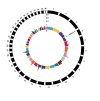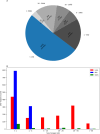A comprehensive map of copy number variations in dromedary camels based on whole genome sequence data
- PMID: 39462079
- PMCID: PMC11513024
- DOI: 10.1038/s41598-024-77773-0
A comprehensive map of copy number variations in dromedary camels based on whole genome sequence data
Abstract
Copy number variants (CNVs) are structural variants within the eukaryotic genome that vary among individuals of a species. These variants have been associated with different phenotypic traits, making them a valuable consideration as markers for designing breeding programmes. In this study, whole genome sequence data of 60 dromedary camel samples originating from the Arabian Peninsula were analyzed to construct a comprehensive dromedary CNV map. Utilizing four CNV callers employing read-depth, split-read and paired-end mapping approaches, a total of 37,519 CNV events (17,847 deletions and 19,672 duplications) were called on the dromedary autosomes. These CNV events were merged into 2,557 regions, categorized as 1,322 losses, 122 gains, and 1,113 "mixed regions" comprising both types. The cumulative size of the CNV regions amounted to 22.5 Mb, covering roughly 1.16% of the dromedary autosomes. Approximately 32% of the defined CNV regions (comprising 60% losses, 18% gains, and 0.27% mixed regions) were found in ≥ 90% of the dromedary samples, classifying them as prevalent regions. Genes with biological functions related to the different adaptive physiologies of dromedary camels, such as fertility, heat stress, musculoskeletal development, and fat metabolism, were overlapping with or in close proximity to ~ 68% of the defined CNV regions, demonstrating their potential role in dromedaries' physiology. This study presents the first comprehensive CNV map of dromedary camels and builds on the present knowledge in understanding the genetic structure of this species.
Keywords: Copy number variants; Paired-end mapping CNV caller; Read-depth CNV caller; Split-read CNV callers; Structural variants.
© 2024. The Author(s).
Conflict of interest statement
The authors declare no competing interests.
Figures




Similar articles
-
Homogeneity of Arabian Peninsula dromedary camel populations with signals of geographic distinction based on whole genome sequence data.Sci Rep. 2022 Jan 7;12(1):130. doi: 10.1038/s41598-021-04087-w. Sci Rep. 2022. PMID: 34997084 Free PMC article.
-
Positive selection footprints and haplotype distribution in the genome of dromedary camels.Animal. 2024 Mar;18(3):101098. doi: 10.1016/j.animal.2024.101098. Epub 2024 Jan 30. Animal. 2024. PMID: 38377812
-
Genetic variants analysis of three dromedary camels using whole genome sequencing data.PLoS One. 2018 Sep 20;13(9):e0204028. doi: 10.1371/journal.pone.0204028. eCollection 2018. PLoS One. 2018. PMID: 30235280 Free PMC article.
-
Aspects of Molecular Genetics in Dromedary Camel.Front Genet. 2021 Oct 21;12:723181. doi: 10.3389/fgene.2021.723181. eCollection 2021. Front Genet. 2021. PMID: 34764978 Free PMC article. Review.
-
Exome sequence read depth methods for identifying copy number changes.Brief Bioinform. 2015 May;16(3):380-92. doi: 10.1093/bib/bbu027. Epub 2014 Aug 28. Brief Bioinform. 2015. PMID: 25169955 Review.
References
-
- Tibary, A. & El Allali, K. Dromedary camel: A model of heat resistant livestock animal. Theriogenology. 154, 203–211. 10.1016/j.theriogenology.2020.05.046 (2020). - PubMed
-
- Musa, H., Shuiep, E. & El-Zubeir, I. Camel Husbandry Among Pastoralists in Darfur, Western Sudan. Nomadic Peoples. 10, 101–105. 10.3167/082279406780246438 (2006).
MeSH terms
Grants and funding
LinkOut - more resources
Full Text Sources
Miscellaneous

